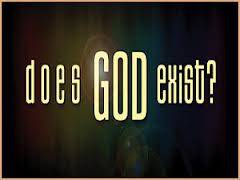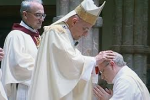God Exists – I Can Prove It! Pt. 1

As a Catholic apologist, I hear way too many sad stories from parents telling of children gone astray. Little Johnny (or little Janey) went off to college and got “enlightened” as to the truth about God and science. The refrain is repeated: “Science has disproved the existence of God, mom and dad. All that we know or can know exists is what we see in the material universe and that can be scientifically proven. Any notion of ‘spirit’ or a ‘supreme being’ is based purely on emotion and wishful thinking.”
The parents are always devastated and often ill-prepared to deal with their newly atheistic child.
In this blog post, and the next, I will offer recommends in the way of step by step instructions concerning just how to demonstrate to even the most skeptical of skeptics that God both exists and loves each and every one of us infinitely!
A Response for Johnny:
1. The idea that “all we can know is what we can see” represents a logical contradiction at its core. And it has nothing to do with true science. In fact, this is not a scientific claim at all; it’s a metaphysical statement, and therefore, self-refuting. Saying there is no God is to claim knowledge beyond the material, which little Johnny (and all true atheists) says can’t be known.
2. This statement is not only non-scientific, but it is, quite ironically, contrary to science in this sense: No scientist has ever seen a sub-atomic particle, yet, none that I know of would deny the existence of sub-atomic particles. Scientists examine the effects of these particles and from those effects conclude the particles must exist, even though they cannot see them. Moreover, scientists are nearly unanimous that there are certain patterns, or laws of nature, in the universe that govern all that we see, but no scientist has ever “seen” them either. Indeed, physicists tell us that there are more than 30 “cosmological or physical parameters” (more on that below) that govern the material universe, each having to be calibrated with a precision that boggles the mind in order for life to exist in the universe. No one has ever seen any of them!
So considering the fact that God is, by definition, pure spirit; it should come as no surprise that he cannot be “seen.” And most importantly, the fact that he can’t be seen does not mean we cannot prove he exists.
What we will seek to do, then, in these two posts, is present evidence for the existence of God analogous to the scientist who presents proof for the existence of a sub-atomic particle. We will demonstrate from the nature of material universe, considered as an “effect,” that it must of necessity have a creator–a cause. And we will then seek to discover what we can naturally know of the nature of that (first) cause, which is God.
When I say this is “analogous” to the scientist presenting proof for the existence of a sub-atomic particle, I want to be clear. This will not be “proof” as in something we can “see” with an electron microscope or measure in a test tube. These are philosophical proofs. But they will be “proofs” that rise to the level that a court of law would say are “beyond a reasonable doubt.”
Cosmological Parameters
When we speak of “cosmological parameters,” we are speaking about certain physical laws, “forces,” or patterns we discover in our universe that cannot be explained via the scientific method. Four examples among the many we could consider are the “forces” of strong nuclear force, weak nuclear force, electro-magnetic force, and gravity.
Scientists may argue over whether these four forces are actually one or two more unified forces with differing manifestations, or that they are four distinct forces, but they generally acknowledge that these forces we have discovered in our universe are real.
Most importantly, these four forces are radically fine-tuned in their force strengths, and, it would appear, necessarily so. If the “tuning” of these forces were to be altered in the slightest, the universe we know would not exist.
Here arises the problem for the atheist. How did these physical forces come into being and how did they get themselves as “finely-tuned” as they are? Think about this: We only named four, but there are 30+ cosmological parameters include things like “the cosmological constant,”—the energy density of so-called empty space (that is actually not “empty” at all)—the certain ratio of carbon to oxygen produced inside stars, the difference in mass between neutrons and protons, and this is just to name a few more. Physicists in general speak of these as “fine-tuned” because even the slightest change in any of their properties would prove devastating to the universe as we know it and most especially for the prospects of there being life in the universe. How do we explain this “fine-tuning” without a “fine-tuner?”
The Gravity of the Situation
If we consider just one of these over thirty cosmological parameters—gravity—we discover a precision that betrays an intelligent source. Remember, there is an enormous range of possible force strengths in nature. There is no necessity involved with the “fine-tuning” of the force of gravity or any of the other physical forces. Dr. Robin Collins, PhD, has described this precision like this:
Imagine a ruler, or one of those old-fashioned linear radio dials that goes all the way across the universe… broken down into one-inch increments. The entire dial represents the range of [possible] force strengths in nature…
Now, let’s imagine that you want to move the dial from where it’s currently set. Even if you move it by one inch the impact on life in the universe would be catastrophic.
And we are only considering one cosmological parameter here. When you begin to add up the numbers with regard to all of the cosmological parameters required for there to be life in the universe, it becomes obvious to the unbiased observer that somebody has been tinkering with things here!
If we add just one more of these finely-tuned parameters—”the cosmological constant” (i.e., the energy density of so-called “empty space” that allows matter to cluster together so that we can have things like galaxies, stars and solar systems), we find the fine tuning to be to the order of “one part in a hundred million trillion trillion trillion trillion trillion trillion.” That number roughly equals the entire number of atoms in the universe!
Just to give you a sense of what we are talking about here, the chances of just these two cosmological parameters among the more than thirty to have been “fine-tuned” by happenstance and without intelligent intervention would be akin to painting one atom among all atoms in the universe red, shaking them all up, and then picking the red atom out of a universe-sized hat! It’s evidence like this that has led even a leading evolutionist like Sir Fred Hoyle to say,
… a superintellect has monkeyed with physics, as well as with chemistry and biology, and… there are no blind forces worth speaking about in nature. The numbers one calculates from the facts seem to me so overwhelming as to put this conclusion almost beyond question.
And these parameters are intimately interwoven as well. According to Collins:
… recent studies by the physicist Heinz Oberhummer and his colleagues show that just a one-percent change in the strong nuclear force would have a thirty-to a thousand-fold impact on the production of oxygen and carbon in stars.
Without oxygen and carbon existing in a proper ratio to sustain life, life in the universe is impossible. Or, consider the difference in Mass between neutrons and protons: Increase the mass of the neutron by about one part in seven hundred and nuclear fusion in stars would stop. There would be no energy source for life. And we could go on and on.
Perhaps They “Just Exist”
In a recent dialogue with an atheist, and after I presented the above and more to him, his response was, “You make interesting points, but I would argue that these so-called cosmological parameters just exist. They weren’t created at all. They’ve just always been there.”
The amazing thing here is this fellow did not seem to realize his obvious contradiction. He had earlier stated his belief that all we can know is what we can prove scientifically. So where might we find scientific proof for such a statement as this? “They’ve just always been there?”
There is none.
But I must say my atheist friend then surprised me. He conceded the point, but then proceeded to challenge me saying, “I may not be able to prove that statement scientifically, but you can’t prove that your God is the source of these cosmological parameters either.”
It’s On!
Without belaboring the point that this atheist was actually making a declaration of faith–oh, the irony–the fact is, we can prove God to be the source not only of all the “cosmological parameters” in the universe, but we can demonstrate him to be the source of the entire universe and all of its parts. And in some ways, it is actually scientific discovery that is pointing the way today to this conclusion as never before. The most recent discoveries in science have led many scientists such as the esteemed quantum physicist John Archibald Wheeler, former president of the American Physical Society and professor of physics at Princeton University, as well as recipient of the Einstein Award and member of the National Academy of Sciences, to conclude that what underlies all existence is not matter; rather, it is an idea, “the ‘bit’ (the binary digit) of information that gives rise to the ‘it,’ the substance of matter.” In other words, science seems to point to the first cause of the universe being rational. Roy Abraham Varghese quotes Wheeler as making a fascinating statement about the movement of science in our time:
The quantum physicist John Archibald Wheeler has said that his lifetime in physics was divided into three periods: (1) “everything is particles,” (2) “everything is fields,” and now, (3) “everything is information.”
It appears that from the macro-level of the cosmos to the microscopic world of the cell and DNA, to the atomic and sub-atomic level, science points us to the realization that there is a wisdom and rationality to our universe that simply cannot be explained by examining the material alone. Attempting to discover the ultimate answers for existence in matter alone would be like looking for the first cause of a Shakespearian sonnet by examining iambic pentameter and the ink and paper upon which the sonnet is written. As Varghese describes it, in nature “information precedes its manifestation in matter.”
Another esteemed physicist, Dr. Gerald Schroeder, puts it this way:
A single consciousness, an all-encompassing wisdom, pervades the universe. The discoveries of science… have moved us to the brink of a startling realization: all existence is the expression of this wisdom.
In his own earth-shattering research and discoveries, the great Albert Einstein saw science pointing to the existence of reason—the logos—as necessarily preceding the material universe:
Whoever has undergone the intense experience of successful advances in this domain [science] is moved by profound reverence for the rationality made manifest in existence… the grandeur of reason incarnate in existence.
If you think about it, the idea of “chair” is qualitatively different than the physical chair I am sitting in. I could burn this chair until there is nothing but ash remaining. This particular “chair” would then be gone. But would the idea of chair be gone? Of course not! An idea is non-material; it is spiritual. Indeed, the idea of chair in the mind of the maker of that chair preceded that chair. Well, science is pointing in the direction of the “idea” of the universe preceding the creation of the universe itself.
At this point, all we’ve done is to show that examination of the material universe points to an intelligence behind the material universe. This does not mean this intelligent source is “God.” How do we prove that to be the case?
Making the First Motion
St. Thomas Aquinas gave many gifts to the world by way of philosophy and theology, but perhaps his most well-known are his famous “five ways” to prove God’s existence. But before we can start to explain them, we must first get acquainted with some foundational principles that will help us to understand these proofs. And these are principles that most scientists would agree with today.
1. St. Thomas’s proofs are based on the observable and knowable first principles that objects and beings we encounter every day are in motion, caused, and contingent. Moreover, as we examine these objects and beings we find they each possess various degrees of perfection and they are ordered toward particular ends. Yet, there is not a single object or being we see that can explain the origin of any of these phenomena. And most importantly, no finite being or object could ever explain these phenomena.
2. Let’s break down what we mean by “no finite being could ever explain these phenomena.” First, let’s consider “motion.” Every high school physics student knows Sir Isaac Newton’s three laws of motion. One aspect of the first of those laws tells us that every object at rest will remain at rest until it is acted upon by an object already in motion. Thus, according to scientific principle, the explanation for the motion of every object or being in motion is not within itself; its motion originates from another. This is good science.
Second, let’s consider “cause.” It is integral to the scientific method to understand that no finite thing or being can cause itself. That would mean it would have to be before it existed, which is absurd. This is foundational to science because the scientific method seeks to discover the natural cause to every natural effect. This presupposes that there is, in fact, a natural “cause” to every natural “effect.”
Third, let’s consider “contingency.” And again this is good science. Everything we see in the universe is contingent. It can either be or not be because it owes its very existence to other things or beings. That is what we mean by contingent being. Thus, no thing or creature that exists or has ever existed can explain or is the source of its own existence.
Fourth, let’s consider “degrees of perfection” and “order.” We’ll combine the fourth and fifth of St. Thomas’ points by observing that we see things and beings possessing various levels of perfection that are designed into them and that they act for particular ends they did not devise. For example, termites in Africa can keep the interior chamber of their mounds protected to within a few degrees in temperature regardless of whether it is 20 or 120 degrees outside by the “worker” termites spraying small amounts of water on the walls of the inner chamber where the queen is kept and protected. This water along with the construction of and the materials used in constructing the mound, keep the temperature within the needed 2 to 3 degrees centigrade so that the queen is able to lay her eggs. This incredibly complex system was not designed by the termites. There is not one engineering degree to be found among them! And this is one of the simpler systems we see in nature. We don’t have time now, but if we were to examine the human cell with its hundreds of thousands of microscopic working parts, machines within machines, and the complexity of DNA within the cell, which is basically a computer program that provides the blueprint for the construction of proteins, which are the building blocks of life, the argument becomes all the more convincing.
The bottom line is: the “design” we find in nature, whether we speak of DNA or termite mounds comes from without as just an infinitesimal part of a massively complex design we see in nature that cannot be explained by nature itself.
So What?
The response I have received more than once at this point of the discussion with atheists is to say, “So what if every thing and every being owes its motion, cause, being, perfection and purpose or end to another. What does that prove?”
The answer is simple. There must logically be an unmoved mover, that itself is not moved, yet is the cause of all motion, an uncaused cause, that is the first cause of all, yet not caused, a necessary being, to use Thomistic language, whose essence is existence, meaning simply that it did not receive its being from another—it simply exists, or more precisely, it is existence itself—and a source of all perfection and order that itself does not receive perfection or order from without. This being we are talking about is referred to commonly as “God.”
The Problem With an Infinite Universe
At this point, the discussion will often regress to an argument like this: “Why does matter, motion, or being necessarily have to have a beginning? What if I say matter has been in motion forever? In other words, how do you know the universe—and motion—is not eternal? And you still have not explained why this ‘God’ of yours would have to be infinite. I’m not buying it!”
There are two major problems with an “infinite material universe.”
1. An infinite universe is contrary to what science has uncovered. There is a growing consensus among scientists today that the universe had a beginning. Since the discoveries of the Hubble telescope in the 1920’s, the laws of thermodynamics and the reality of entropy, and Einstein’s theories of relativity, speculation about an infinite universe has become antiquated. Let me explain:
The Hubble telescope has given us overwhelming evidence, as was predicted by scientists like Fr. Georges Lamitre, a Belgian physicist and Catholic priest, that all of the galaxies and clusters of galaxies in the universe are moving away from each other, and somewhat surprisingly increasing in speed, yet from one central point in a uniform fashion. This means there was a “time” when the entire universe was reduced to a single point physicists refer to as “singularity.” All physical laws that we know of seem to break down at this point and all attempts to explain this beginning end up employing infinity, e.g. “infinite density,” in order to even begin to understand it. This mysterious beginning of our universe has been labeled as “the Big Bang.” Believers in the world’s great monotheistic religions call it “creation!” But most importantly, it represents a beginning.
The second law of thermodynamics tells us that the amount of entropy in the universe is constantly increasing. In other words, the amount of usable energy in the universe is decreasing, or tending toward entropy (this is why your morning cup of coffee goes from hot to tepid and why broken coffee cups don’t mend themselves, apart from intelligent direction). That would mean that the universe started with an immense amount of energy (scientists tell us ca. 13.7 billion years ago) and that one day the universe will run out of usable energy. That would mean there was a fixed beginning as well when it comes to energy.
And finally, Einstein demonstrated what has stood up to and has been confirmed by experiment after experiment over the years: energy, matter, velocity, time and space are all relative. His famous equation E=Mc2 tells us that energy equals mass times the speed of light squared. The key here is that “equals” sign. This means energy is just another form of matter and matter is another form of energy. And very importantly, it tells us they are relative to one another along with velocity, time and space. If there was a beginning with regard to energy—and we know there was—there was a beginning with regard to matter. Time is the measurement of the motion of physical bodies and thus would be relative to energy and matter as well. Thus, “time” has a beginning. And space would be relative as well because space itself is “created” by the relative position and direction of objects and events. Velocity is a quantifying of the rate of the change of position of objects. Thus, energy, matter, velocity (or motion), time and space are all relative and all have a beginning.
2. As Trent Horn points out in his book, “Answering Atheism,” available at Catholic Answers, an infinite universe cannot be. He uses the example of a woman who owns a flower shop. Every morning before she opens her shop, she has to count all of her flowers she will be selling for inventory purposes. What if she had an infinite number of flowers to count before she could open? She could never open her shop!
In the same way, if there were an infinite amount of time, or let’s say, an infinite number of “days,” there could never be a “today,” because we could never exhaust the days leading up to “today.” I argue that positing an infinite material universe is like positing a square circle. It is logically impossible.
Final Thoughts
Muslim, Jewish and Christian philosophers and theologians have been saying for centuries what scientists are finally coming around to seeing: “In the beginning God created the heavens and the earth!” If energy, matter and therefore time have a beginning, they had to be brought into being. And if this is so, they would have had to be brought into being by something or someone that is immaterial and exists outside of time and space. Moreover, this something or someone would have to have infinite power in order to bring something into being from nothing. Sound familiar? We’ll speak more about this “something” or more accurately “someone” in our next post. And we’ll also get to how we can know this someone loves us!
If you enjoyed this, get more information by clicking here.





